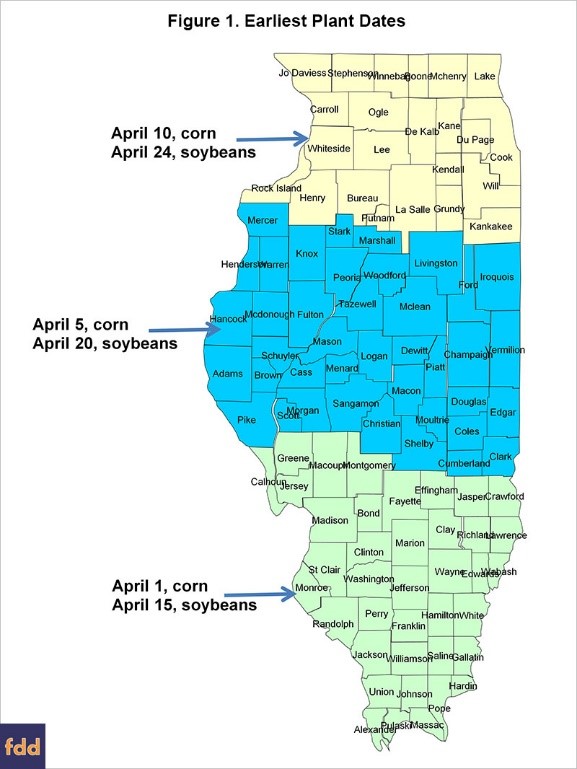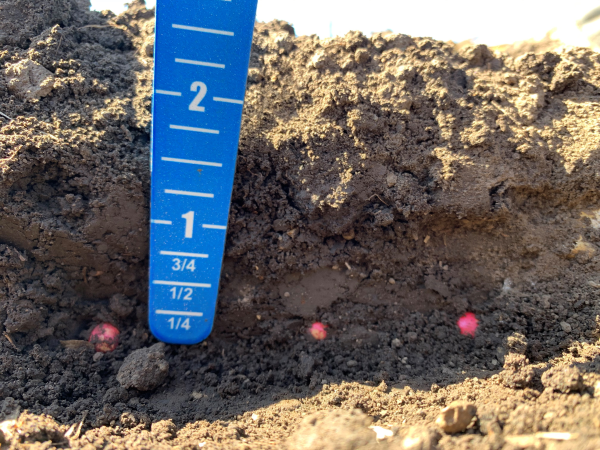Every year there is more buzz about the value of planting soybeans earlier than farmers have historically done, with good reason. University of Illinois data shows that maximum yields are attained at planting dates prior to May 1, with a 7% yield loss when planting on May 15 and 14% loss on June 1.

insurance eligibility. Source: University of Illinois
Researchers generally find that there is little difference in yield when soybeans are planted between April 15 and April 30 and do not recommend planting earlier than April 15. If you are concerned about insurance coverage, check with your crop insurance agent to see what the early planting date is for your county (Figure 1).
Kris Ehler, agronomist and former CCA Soy Envoy, has been planting soybeans early for 11 years and has never had a crop failure. He disagrees with university recommendations that there is no advantage to planting earlier in April. Over the past 6 years, he has seen an average yield increase of 8.7 bushels, including a February planting in 2017 that yielded 86.7 bushels. He likes to remind growers that the early planting insurance date only applies to replant coverage, which is generally offered by seed companies anyway. Ehler is a strong advocate of early planting and, although he does not necessarily recommend that farmers plant soybeans in February or March, he says that he does it “to give growers the confidence to plant on April 5 if there is a planting window and the forecast looks good.”
Seed Protection
A couple of the reasons that growers are able to plant soybeans earlier than ever before are improvements in seed quality and the widespread adoption of seed treatments. These advances allow seed to be placed into cooler soils and provide protection until the soil warms enough to allow germination, which begins at around 50°F. However, all seed treatments are not created equal. When planting early, be sure to choose an effective treatment that includes an insecticide. This is especially critical in early plantings because the seeds will likely take longer to germinate, making them more susceptible to attack from soil dwelling insects.
Planting Population
If you are going to put soybeans in the ground earlier than you have in the past, you may be able to achieve maximum yield at a lower population. A planting rate of 125,000 should be sufficient in 30” rows and possibly even lower. If you are uncomfortable with drastically reducing population, consider dropping your normal rate by 10,000 – 15,000 seeds/acre and evaluate performance. Today’s equipment allows planting at different rates throughout the field and digital tools easily analyze harvest data to evaluate population performance on your farm.
Planting early gives soybeans more time to reach their full potential by allowing maximum vegetative growth before flowering begins. A lower population also provides less competition for resources, which should improve seed set and pod retention. Soybean plants grow more branches when they have more space, which means more sites at which pods can be set. One drawback to reduced populations is that the stems of the plants will be larger, possibly leading to harvestability challenges. Any seed cost savings can be allocated to a planned R3 fungicide application, which should help reduce stress and maintain yield potential.
Variety Selection
Another consideration for early planting is that growers can take advantage of the yield potential of fuller season varieties. If you are generally comfortable planting a 3.4 variety, a 3.6 or 3.7 would not be out of line. Ehler points out that a 3.6 variety planted early will mature around the same time as a 3.4 planted in a normal timeframe. Planting a fuller season variety should provide greater yield potential.
Planting Depth
For years, growers have used the rule of thumb that soybeans should be planted at a depth of 1 to 1-1/2 inches. The recommendation has been to generally use the shallower end of the range when planting into cool soils or those with good moisture. However, recent University of Nebraska research, indicates that the optimum depth for planting soybeans is 1-3/4 inches, regardless of planting date or soil conditions. Planting a bit deeper can protect the seed from changes in soil temperature and moisture prior to germination and provide more even emergence. This lSoyAdvisor post discusses planting depth in more detail.
 In a challenging commodity environment, farmers are extra cognizant of the need to maximize profit. Planting soybeans early is one technique that can be used to increase yield (income) without extra expense. This is not as revolutionary an idea as it may have been a few years ago, since more and more farmers and researchers have been discovering the benefits and fairly low risk of planting early. Many growers don’t realize that soybeans are less susceptible to frost than corn. There is only a very narrow window between when the hypocotyl has emerged from the soil and before the cotyledons are out of the ground when frost is a serious concern. If you are not yet ready to go all in on early planting, consider planting a field or two and see if it makes sense for your operation.
In a challenging commodity environment, farmers are extra cognizant of the need to maximize profit. Planting soybeans early is one technique that can be used to increase yield (income) without extra expense. This is not as revolutionary an idea as it may have been a few years ago, since more and more farmers and researchers have been discovering the benefits and fairly low risk of planting early. Many growers don’t realize that soybeans are less susceptible to frost than corn. There is only a very narrow window between when the hypocotyl has emerged from the soil and before the cotyledons are out of the ground when frost is a serious concern. If you are not yet ready to go all in on early planting, consider planting a field or two and see if it makes sense for your operation.




 and then
and then